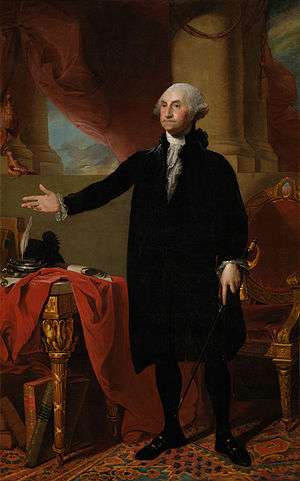Lansdowne portrait
 | |
| Artist | Gilbert Stuart |
|---|---|
| Year | 1796 |
| Medium | Oil on canvas |
| Dimensions | 243.8 cm × 152.4 cm (8 ft × 5 ft) |
| Location | National Portrait Gallery (United States) |
The Lansdowne portrait is an iconic oil-on-canvas portrait of George Washington, the first President of the United States. The portrait was painted by Gilbert Stuart in April 12, 1796 and commissioned by Senator William Bingham of Pennsylvania—one of the wealthiest men in the U.S. at the time—and his wife, Anne. The portrait measures 8 by 5 feet (2.44 by 1.52 m) and was given as a gift of appreciation to British Prime Minister, born William Petty FitzMaurice; the second Earl of Shelburne and subsequently the first Marquess of Lansdowne. Petty-FitzMaurice was an American sympathizer who supported independence of the colonies in Parliament. He succeeded in securing peace with America during his term as Prime Minister of Great Britain.[1] The Lansdowne portrait was completed in the fall of that year by American artist Gilbert Stuart (who made several other portraits of George Washington, and many others of prominent American revolutionaries). The painting shows Washington at 64 years of age renouncing a third term as U.S. President. It is currently on permanent display at the National Portrait Gallery of the Smithsonian Institution. Replicas painted by Stuart are on display in the East Room of the White House, the Old State House in Hartford, Connecticut, and the Pennsylvania Academy of the Fine Arts Museum. Additional copies painted by other artists are displayed in the U.S. House Chamber, the Rayburn room of the Capitol, and the Maryland Historical Society in Baltimore.[2]
In 2001, The Donald W. Reynolds Foundation funded the purchase, for $20 million, of the Lansdowne portrait. The Foundation donated an additional $10 million to provide a dedicated space for it at the National Portrait Gallery where it had previously been on loan.[3]
Description and analysis

The painting is full of symbolism, drawn from both American and ancient Roman symbols of the Roman Republic. Stuart painted Washington from life, showing him standing up, dressed in a black velvet suit with an outstretched hand held up in an oratorical manner. In the background behind Washington is a row of two Doric columns, with another row to the left. Wrapped around and between the columns are red tasseled drapes.
Washington's suit is plain and simple, and the sword that he holds on his left side is a dress sword and not a battle sword (symbolizing a democratic form of government, rather than a monarchy or military dictatorship). In the sky, storm clouds appear on the left while a rainbow appears on the right, signifying the American Revolutionary War giving way to the peace and prosperity of the new United States after the 1783 Treaty of Paris. The medallion at the top of the chair shows the red, white, and blue colors of the American flag.
On and under the tablecloth-draped table to the left are two books: Federalist—probably a reference to the The Federalist Papers—and Journal of Congress—the Congressional Record. Another five books are under the table: the three to the right are General Orders, American Revolution, and Constitutional Bylaws—symbolizing Washington's leadership as commander-in-chief of the Continental Army and president of the Constitutional Convention.
The pen and paper on the table signify the rule of law. The leg of the table is shaped like a fasces, an ancient Roman symbol of power and authority (imperium). On the far left of the table is a silver inkwell, emblazed with George Washington's coat of arms (see Syng inkstand). A white quill rests upon silver dogs, ancient symbols of loyalty. Behind the table is a large black hat.
Washington's unusually clenched facial expression comes from his famous false teeth. Jean-Antoine Houdon's marble sculpture of Washington shows a more natural expression. Stuart wrote that:
- When I painted him [Washington], he had just had a set of false teeth inserted, which accounts for the constrained expression so noticeable about the mouth and lower part of the face...Houdon's bust does not suffer from this defect."
_-_Google_Art_Project.jpg)
The U.S. government bought a copy of this portrait from Stuart. That painting was rescued from the White House during the War of 1812 just before British soldiers captured the mansion, served themselves dinner, and burned it down. First Lady Dolley Madison wrote about saving Washington's portrait and is often credited with the rescue. The memoir of Paul Jennings, who was James Madison's slave and manservant, identifies the doorman John Susé and the gardener Mr. Magraw as the people who removed the portrait for safe keeping.[4] After the incident, several other copies of the portrait were commissioned. The copy which Dolly Madison rescued currently hangs in the East Room of the White House. The copies are easily identified by a misspelling purposely inserted into each, on the spine of one of the books resting on the floor. The book's title (spelled correctly on the original) reads "Constitution and Laws of the United Sates [sic]."
References
| Wikimedia Commons has media related to Lansdowne portrait of George Washington. |
- ↑ www.number10.gov.uk, U.K.Government. "Past Prime Ministers". U.K.Government.
- ↑ Office of the Clerk, U.S. House of Representatives, Artist Gilbert Stuart’s portraits of George Washington. Accessed: May 11, 2012.
- ↑ Donald W. Reynolds Foundation, Special Projects
- ↑ A colored man's reminiscences of James Madison, Paul Jennings, J. B. R., published by G.C. Beadle, 1865, page 15
External links
- "The Portrait." George Washington: A National Treasure. National Portrait Gallery, Smithsonian Institution. georgewashington.si.edu
- Kellogg, Stuart. "By George!" Victor Valley Daily Press (CA). November 16, 2002.
- "If Stuart Didn’t Paint It, Who Did?". ARTnews (October 2004), Bonnie Barrett Stretch
- Google Art Project: White House copy, Brooklyn Museum copy
- Gilbert Stuart, a full text exhibition catalog from The Metropolitan Museum of Art, which contains material on the Lansdowne portrait
- Bryan Zygmont, Gilbert Stuart's Lansdowne Portrait, Smarthistory